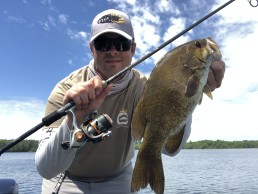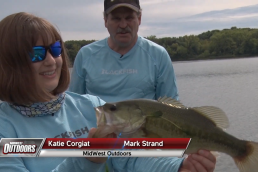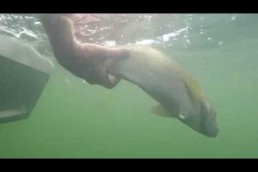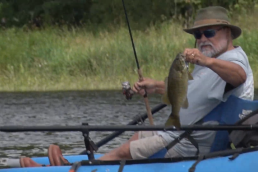Use the Heat of Summer to Your Advantage for Untapped Smallmouth Bass
SHARE THIS POST
The most challenging, rewarding, and steady smallmouth fishing of the season takes place in summer. Depending on your whereabouts, patterns could be habitual or constant from year-to-year. They may revolve around good weather, peak feeding or additional factors.
While summer smallmouth patterns in my neck of the woods are predictable, repeating annually, unexpected events might curtail or prevent them into fully materializing in some years. In this case, when pattern fishing becomes nonexistent, unique windows and situations may emerge out of nowhere that’ll help increase fishing success. You must be alert, identify them and seize the opportunities.

I believe that many anglers endure smallmouth struggles in summer. It’s not that fish have dispersed and become uncatchable, but the expected patterns have evaporated. Fish are always available, and prone to feed heavily in the right time and place.
Fish smarter, not harder. There is no bad time to catch big smallmouths in midsummer. The following insights on behavior, strategies and overlooked patterns can help you use the heat of summer to your advantage.
The early bird gets the worm
In midsummer, smallmouths tend to feed more often in the low-light early morning hours rather than midday. Mistakenly, most summertime anglers typically fish midday. Fish this way, and you’ll encounter more lethargy and inactive fish, rather than active ones. Smallmouths favor cooler waters.
Visit any northern lake on a calm, quiet morning at dawn, and the high amount of surface activity observed should be of no surprise. As water temps are at their coolest point in the day, baitfish and crayfish are actively moving. Smallmouths utilize the reduced light levels and coolest daily water temps to exert their most energy on feeding and movement.
On most early-morning outings, I take advantage of the shallows, where water temps could be in the low 70s. Smallmouths migrate back in shallow to feed and cruise. They won’t stay long, but feeding windows and activity will persist at the discretion of climbing temps. On most lakes, I can usually find a good bite happening in the shallows until the sun starts cooking and water temps climb. Some days, this may last all morning long.
You’d be surprised by the number of smallmouths migrating back into the shallows where they can be in brief, optimal comfort. Don’t neglect surface and open-water bites, either.
By July and August, the early-morning bite is very predictable from first light through the first 2 or 3 hours of the morning. Sunny, warm days are best, but weather can obviously halt it. There is no incentive in getting up early if it’s gloomy, rainy or during a cold front.
Don’t oversleep. Prioritize sunrise until water temps begin to climb steadily. Clock management is important. In July and August, I like to be on the water by 5 am, if possible, and be done fishing by 11 am. Not all anglers have this type of flexibility, however.
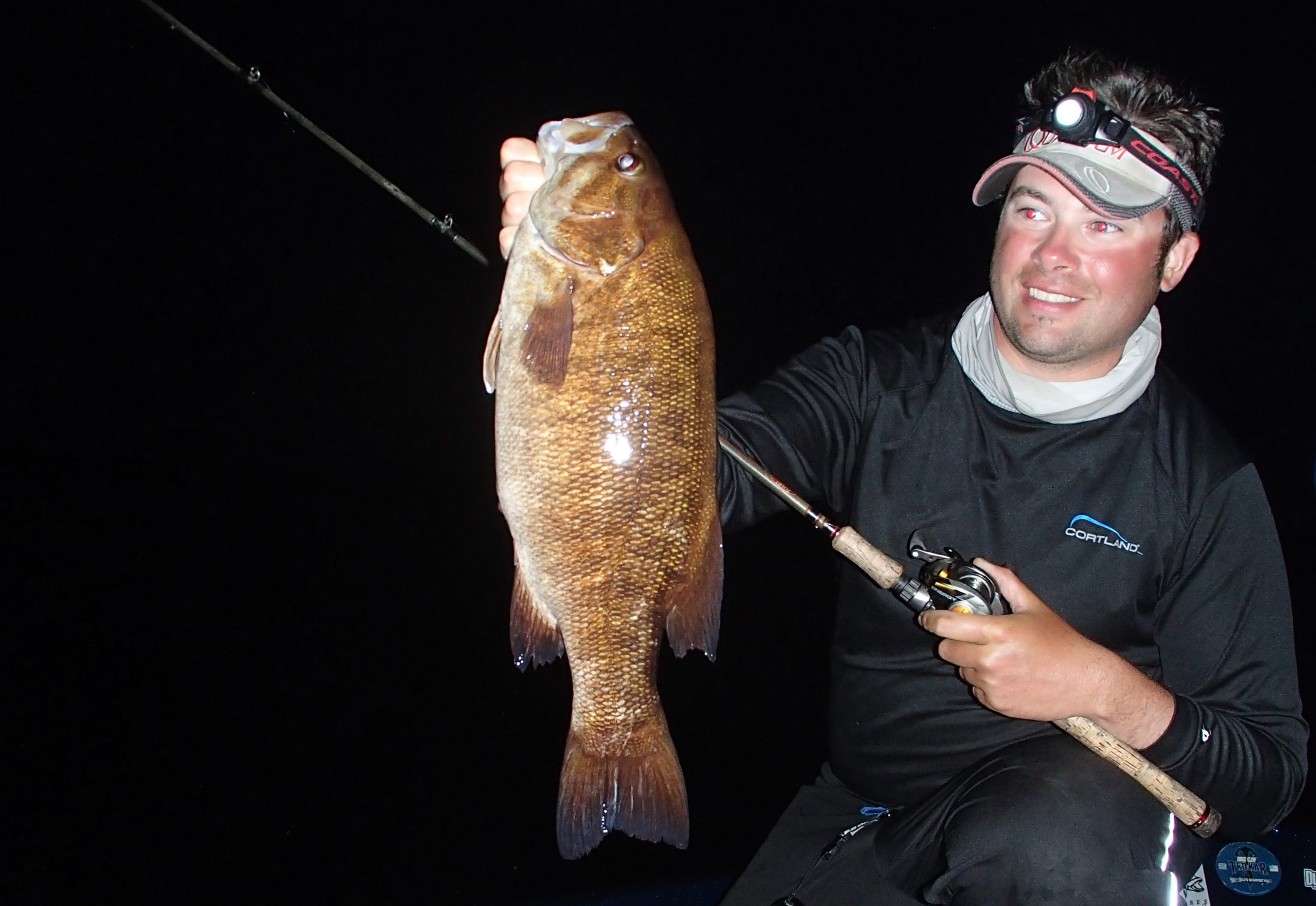
Night hawks
This time of year, surface temperatures on most lakes can peak in the 80-degree range during daytime. Water temperature is at its seasonal peak and can sometimes be warmer than bath water. As sunlight radiates into the water, smallmouths become finicky and irresponsive; they are driven deeper to seek cooler water and lay low. While temporarily seeking sanctuary from the heat, they will eventually return to the shallows each evening as sun penetration lessens, and surface temperatures begin to cool off for the night. Fish don’t stop biting. This temporary shift in location and return to the shallows only makes them feed more.
Heat waves and high-pressure systems make for challenging times and oppressive midday fishing efforts. Fish late to best counter them. This time of year, I prioritize evening and nighttime fishing efforts when conditions allow, especially on calm, humid days.
During the dog days of summer, I catch some of the largest and heaviest smallmouth bass of the season in darkness. My fishing efforts revolve around shallow rock bars, shoals, wood, and spot-on-the-spot areas that are known feeding sites. My program is entirely centered around loud, water-pushing topwaters, noisy crankbaits, and swinging head jigs with craw & creature plastics.
Lasting anywhere from four to six weeks, depending upon region and climates, I’ve observed more big bass feeding at night rather than during daytime. Triggering this feeding are consecutive warm, humid, windless nights with air temperatures warmer than 70 degrees, and water temperatures holding steady at 75 and above.
Heat, humidity, and windless conditions speak extreme difficulty to anglers. While this can be the case for daytime fishing, it’s the preferred nighttime fishing ingredient. The hotter, more humid and more windless it is, the more aggressively smallmouths will feed.
Heat affects the entire ecosystem, and stalls its daytime activity. Correspondingly, heat affects anglers, too, reducing our energy levels and potentially limiting our motivation to fish and withstand the heat. When it dissipates and relief comes, all life forms impacted by it reactivate. Peak feeding takes place. This leads to an explosion of crayfish scavenging the shallows, and perhaps an after-dark insect or nymph hatch. All organisms are in their peak activity for the day, triggering a smallmouth feeding frenzy.
Each evening when I launch the boat, I pay attention to whether I see crayfish scurrying across the plank. If I observe any, I know I’m in for a good night of fishing.
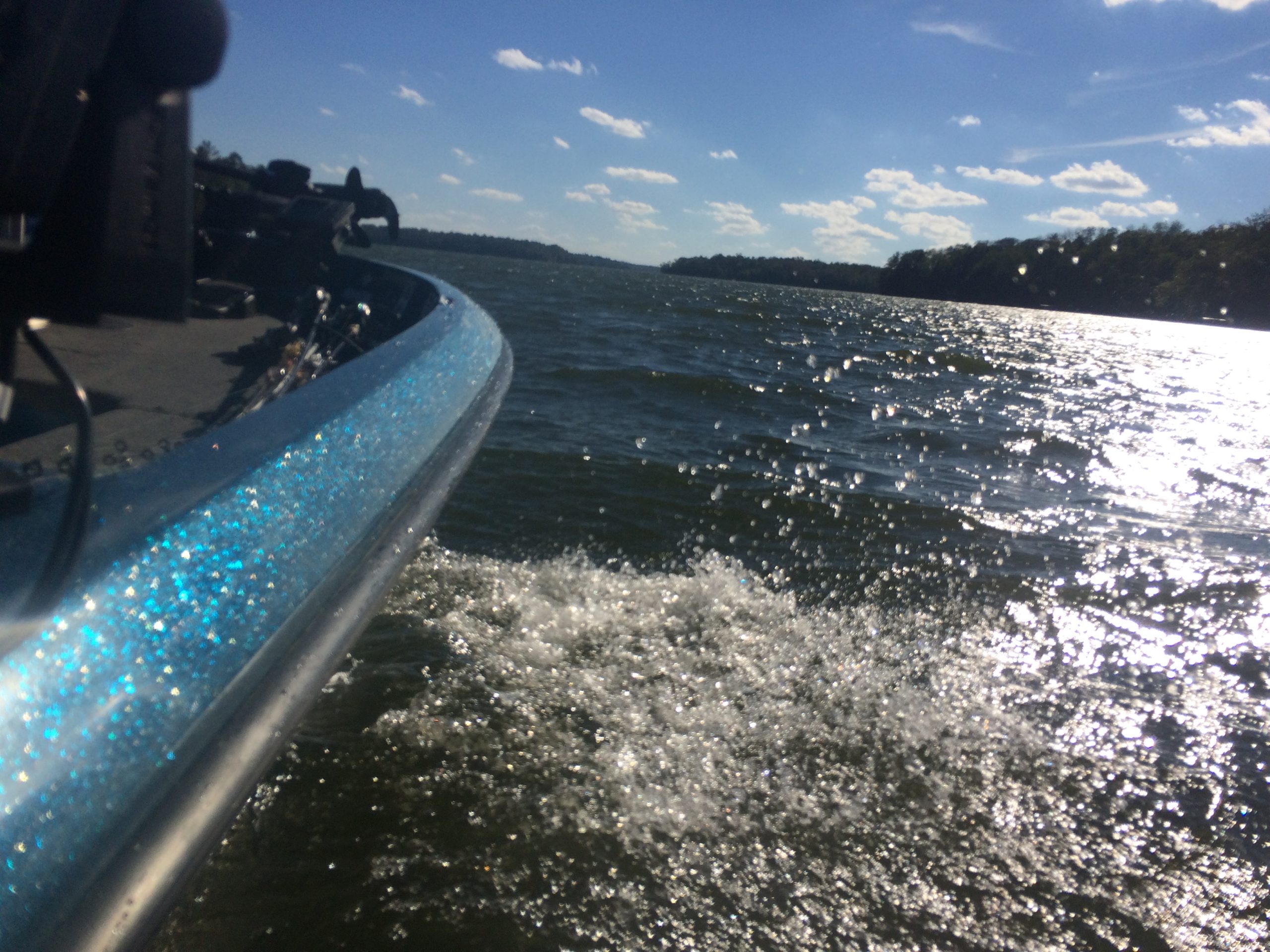
Moving water
The wind is your friend.
Bass anglers often complain about the wind, but they’d have better tolerance for it if they knew how much it can produce a great bass bite. Areas churned up by waves attracts the lake’s entire food chain, from phytoplankton to baitfish and smallmouths. The reduced light penetration also allows you to fish aggressively with crankbaits, spinnerbaits, swimbaits and other horizontal search lures to capitalize on a frenzy of feeding fish. Be mindful that smallmouths still require good water clarity and visibility for these spots to be successfully fished.
When fishing clear lakes, I prefer some wind, especially if it’s blowing hard enough to generate a 1-foot chop. I have confidence that I’ll catch very active fish due to the lake’s food sources and cooler water temperatures being blown into these regions of the lake. Wind drives smallmouths into the shallows, making them easier to catch. It also oxygenates the water, which is a tremendous benefit during midsummer, as it will cool surface temperatures.
Are you enjoying this post?
You can be among the first to get the latest info on where to go, what to use and how to use it!
I often experience a major spike in smallmouth activity during a west and southerly wind accompanied by humidity. There’s nothing worse than cold, dry, east or north winds which wrecks the bite.
Currents, on the other hand, should be sought out on river systems and reservoirs. In midsummer, flowing waters are prime real estate. Moving waters trigger feeding as well as oxygenate the system, perking up everything in the process.

Cleanest, coldest waters
Summer peak sets in at 75-degree water temperature, And thermoclines fully develop. Most smallmouths by now are seeking deep and cool water near the thermocline that is most oxygenated and comfortable for them. They may dwell along deep structure or even suspend in open water in main-lake basin areas.
To stay on top of big bass and big bites throughout summer, fish the deepest and clearest lakes. These are commonly cisco systems, and some even trout water, and will remain cool throughout the season, catering best to trophy smallmouths. Summer heat cannot penetrate through them as effectively and detrimentally like it does to river systems and dark water lakes at this time of year—a reason I rarely ever fish them for smallmouths after June.
To maintain their weights, big smallmouths require high-protein meals. The ciscoes availability on clean, colder waters helps them achieve their wide bodies and grouper-like stature.
Ultimately, fish are looking for the coolest, most comfortable waters they can find. Summer season movements are minimal, with most of them taking place between corresponding deep and shallow structures.
Structure and topography
Smallmouths are structure-oriented fish, and thrive in waters with topography. As such, you must prioritize fishing waters that offer lots of underwater contour.
To identify spots and underwater structure, you must be good at map reading and image interpreting. Marine electronics are so good these days that even a first-time visitor to a lake can use side-imaging and forward-facing live sonar to quickly learn the water and find fish.
When navigating your way around a lake, idle around potential locations and chart those areas first until you feel more comfortable fishing them. From my console, I run two networked Lowrance HDS-12 Live screens: one with full-screen side imaging only, and the other a combination of C-Map Reveal and CHIRP. On every new smallmouth fishery I visit, I intently study the screens in attempt to learn everything about it.
Fishing any lake successfully requires a keen sense and comprehension of underwater topography via electronics use. Before any fishing, strive to always chart your locations and the water beforehand. Make the time for this essential habit. You will then fish deep structure more effectively afterwards.
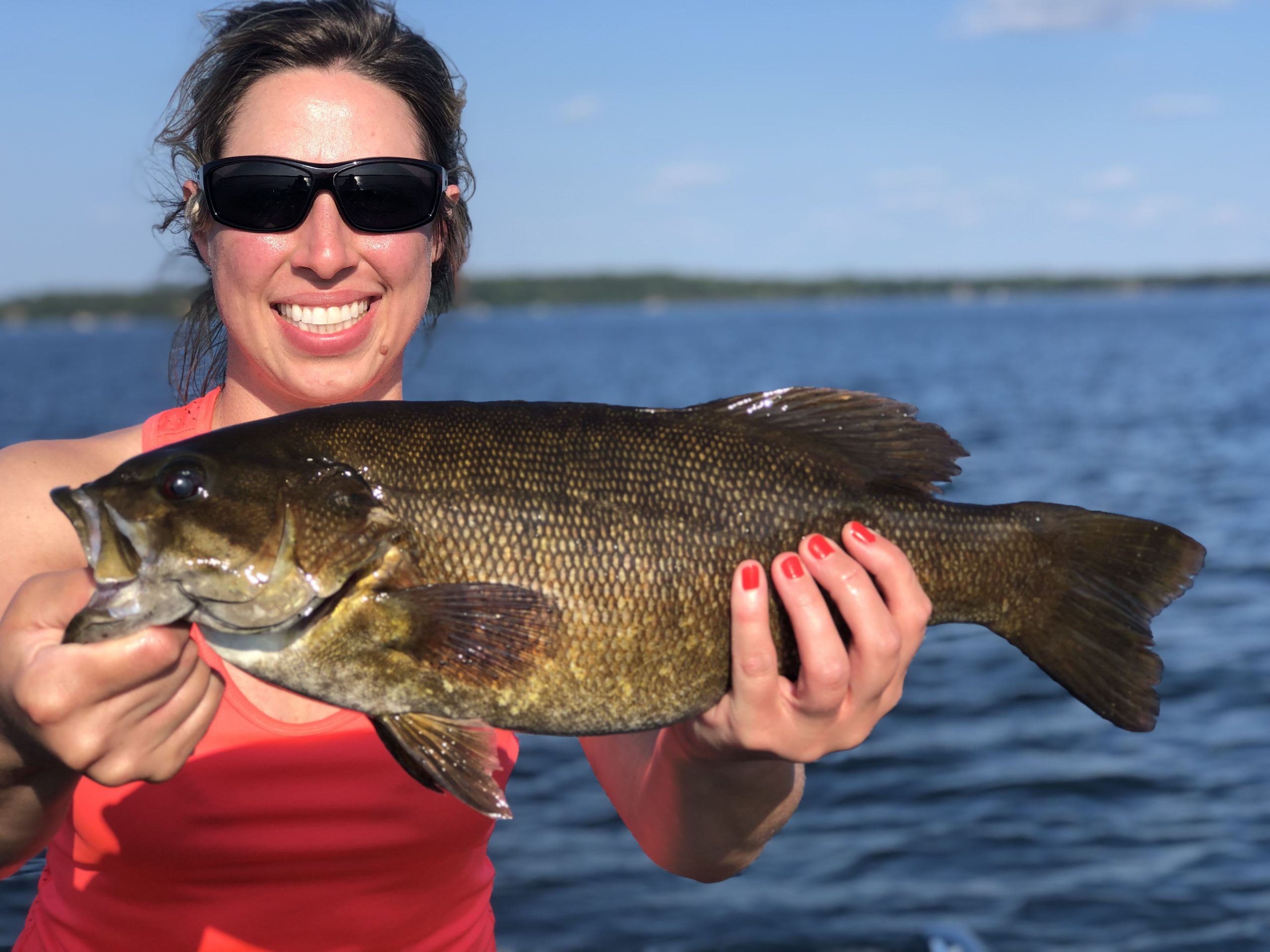
Bombs away
Never hesitate to pursue big smallmouths on light tackle. Today’s age of specialized strategies calls for rods of longer lengths paired with high-capacity reels for presentation needs, as well as for casting farther with less effort and fatigue.
I am a long-rod proponent, owning several spinning and casting setups in lengths between 7 and 8 feet.
Most of the smallmouths that I catch in summer are deep, open-water oriented fish. To reach them with casting presentations, I need to make very long casts. With the long rod, I am not only able to cover larger expanses of water but achieve hooksets from long distance due to their faster tapers and tip actions. This segment of the rod serves as a shock absorber, as open-water smallmouths are known for vicious strikes and quick surges.
The key is having a rod long enough, fast enough, and in a power range light enough to protect thin line and keep up with big smallmouths. Several rod manufacturers today have introduced longer rods designed for light line and long casts.
Anyone familiar with my writing, or who’s been aboard my boat in the last year, knows I work with several different St. Croix setups ranging in lengths from 7’ 5” to 8 feet.
The St. Croix Victory Open Water and Legend Tournament Swimming Bait spinning rods leave no guessing as to what they excel at: Launching baits in big water, open-water scenarios. My boat does a lot of offshore casting and search bait fishing with them during the summer months. These rods can easily launch 1/16- and 1/8-ounce jigs into the abyss and set hooks way out there. The big bend and pressure maintained on the fish won’t ever allow a trophy smallmouth to defeat you.
Complement these rods with a long-cast ,3000 or 4000 size spinning reel spooled with 5- to 10-pound Cortland Masterbraid, and you have the perfect medium- to moderate-action lure launcher to cast baits far while still being able to make contact with fish and hold on to long-distance hooksets. The large-capacity spinning reels I fish with have zero effect on the weight distribution or balance with the rod. The long length of the rod enables you to hang on to fish that typically strike mid-retrieve, and from several yards out.
Smallmouth fishing strategies are quickly evolving more to open-water patterns. Whether you finesse fish or power fish, add a long rod or two into your bag of tricks.
Summer’s swelter is notorious for delivering the most difficult fishing and challenging conditions of the year. Bites can be less aggressive, and are driven deep during daytime, becoming even more difficult to locate.
Dog days, hot weather, warm water temperatures, lake stagnation and passive bites each contribute to the struggle. Follow these guidelines, and your summer season fortunes will change.
MWO
SHARE THIS POST
Did you enjoy this post?
You can be among the first to get the latest info on where to go, what to use and how to use it!
Andrew Ragas
Andrew Ragas splits time between Chicago and Wisconsin’s Northwoods. Based in Minocqua, Wis., he specializes in trophy bass fishing and offers guided trips from May through October. While big bass are his passion, he dabbles in multispecies, as well. He may be visited online at northwoodsbass.com
